Wake-on-LAN is an Ethernet networking standard that allows a properly configured network computer to be turned on or awakened by a network message. In this post, we will provide comprehensive solutions you can try to successfully resolve issues where Wake-on-LAN (WOL) is not working on your Windows 11/10 computer.
Wake-on-LAN (sometimes abbreviated WoL) is an industry-standard protocol for waking computers up from a very low power mode remotely. The definition of “low power mode” means while the computer is “off” and has access to a power source. This is useful if you plan to access your computer remotely for any reason: it allows you to retain access to your files and programs while keeping the PC in a low-power state.
Before you proceed with the solutions outlined below, do the following prechecks:
The primary Ethernet port is usually on the side or the back of the system, and it is listed as Ethernet 1 when you run IPCONFIG. This is the port that supports Wake-On-LAN.
Once you have confirmed that the network cable is connected to the NIC on the system, if Wake On LAN still doesn’t function properly, troubleshoot using the following steps:
- Confirm that the AC power is plugged in. WOL does not work when the system is running on battery. This is by design.
- Confirm that the link light remains on when the system is powered off. If there is no link light, then there is no way for the NIC to receive the magic packet to wake the system.
- Confirm that the client system can be pinged by the system that is sending the magic packet.
- Confirm that the MAC address used in the magic packet matches the MAC for Ethernet 1 on the client system.
- If an IP address is specified in the magic packet, then the network switch may not properly broadcast it to the whole network. It may be necessary to change the address to broadcast the packet to the whole network. For example, if the client address is 192.168.1.12, the broadcast address used in the packet would be 192.168.1.255.
Wake-on-LAN not working
If you’re faced with this issue, you can try our recommended solutions in the order presented below and see if that helps to resolve the issue.
- Disable Fast Startup
- Update Network Interface Card (NIC) driver
- Change Power Plan settings
- Configure NIC Power Management settings
- Configure NIC Advanced Driver Properties
- Modify Registry key
- Manually create Registry key
- Check BIOS settings
- Reset BIOS
- Update BIOS.
Let’s take a look at the description of the process involved concerning each of the listed solutions.
1] Disable Fast Startup
The Fast Startup feature in Windows 10 is enabled by default if applicable. Fast Startup is designed to help your computer startup faster after you shut down your computer. When you shut down your computer, your computer actually enters a hibernation state instead of a full shutdown.
This solution requires you to disable Fast Startup and see if the Wake-on-LAN not working issue is resolved.
2] Update Network Interface Card (NIC) driver
Problems with Wake-on-LAN feature can be caused by your network drivers, and if you have this problem, you should try updating the NIC driver to the latest version.
You can either update your drivers manually via the Device Manager, or you can get the driver updates on the Optional Updates section under Windows Update. You can download the latest version of the driver from the manufacturer’s website.
If updating the NIC drivers to the latest version and the issue still persists, you can try installing the older version of the network adapter driver.
3] Change Power Plan settings
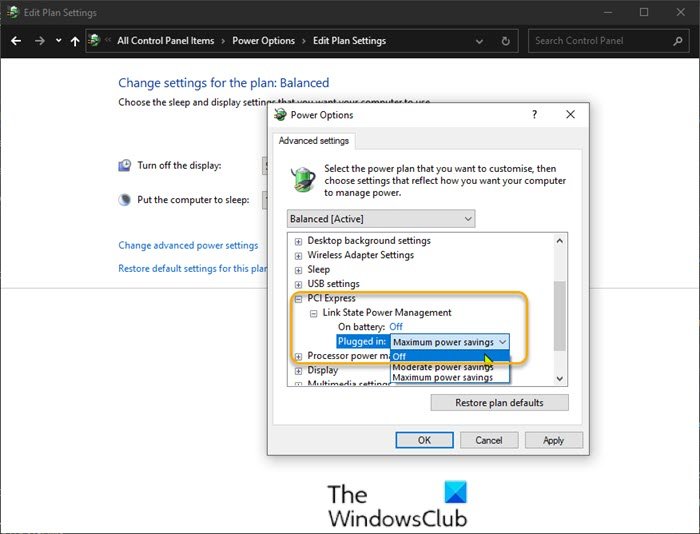
Do the following:
- Right-click the battery icon on the notification area on the right of the Taskbar.
- Select Power Options.
- In the Power Options window, locate your current Power Plan.
- Click on Change plan settings next to it.
- Now click on Change advanced power settings.
- Expand PCI Express section.
- Expand Link State Power Management.
- Now set power saving to Off for both On battery and Plugged in state.
- Click Apply > OK to save changes.
The issue should be resolved now. If not, try the next solution.
4] Configure NIC Power Management settings
The following configuration is for the Intel NIC.
- Press Windows key + X to open the Power User Menu.
- Press M key on the keyboard to open Device Manager.
- Once you’re inside Device Manager, scroll down through the list of installed devices and expand the Network adapters section.
- Right-click the primary network adapter (the first adapter in the list is usually the primary adapter) and select Properties.
- Select the Power Management tab.
- Check the boxes for Allow the computer to turn off this device to save power, Allow this device to wake the computer and Only allow a magic packet to wake the computer.
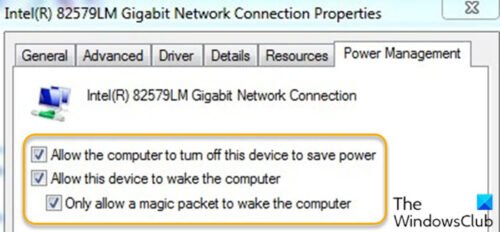
- Depending on your Intel NIC, if available, check the Wake on Magic Packet and Wake on Pattern Match option and uncheck the Reduce link speed during system idle under Power Saver Options.
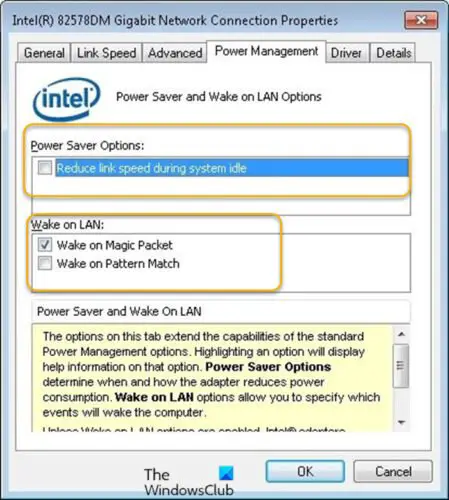
- Click OK.
- Restart your computer.
5] Configure NIC Advanced Driver Properties
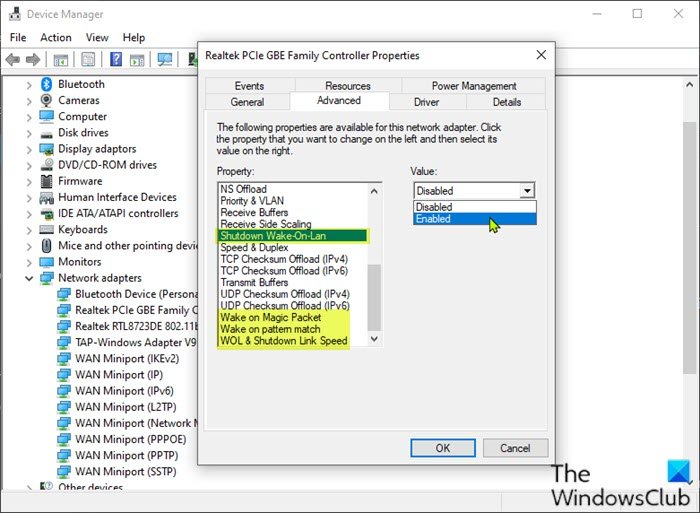
Check the NIC driver properties in Windows and ensure that WOL is enabled there. These settings can override the BIOS in Windows 10.
The following configuration is for the Realtek PCIe GBE network adapter.
- Open Device Manager.
- Expand the Network adapters section.
- Right-click the Realtek PCIe GBE Family Controller and select Properties.
- Click the Advanced tab.
- In the Property box, select one after the other; Shutdown Wake-On-Lan, Wake on Magic Packet, Wake on pattern match and set the Value to Enabled.
- Then, lastly select WOL & Shutdown Link Speed and set the Value to 10 Mbps.
- Click OK when done.
- Restart your computer.
6] Modify Registry key
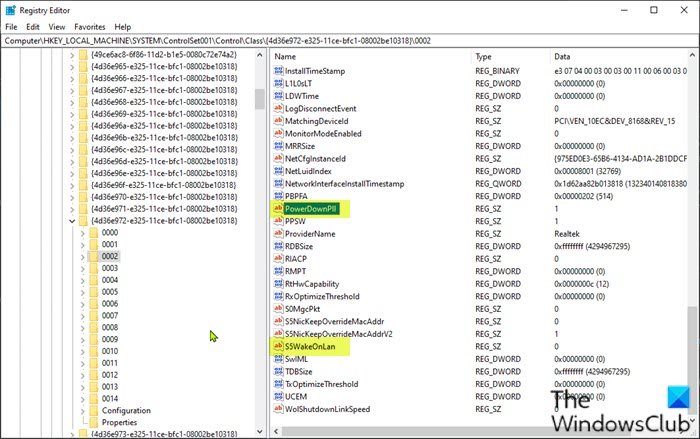
This method worked for Realtek network adapters.
Since this is a registry operation, it is recommended that you back up the registry or create a system restore point as necessary precautionary measures. Once done, you can proceed as follows:
- Press Windows key + R to invoke the Run dialog.
- In the Run dialog box, type
regeditand hit Enter to open Registry Editor. - Navigate or jump to the registry key path below:
Computer\HKEY_LOCAL_MACHINE\SYSTEM\ControlSet001\Control\Class\{4d36e972-e325-11ce-bfc1-08002be10318}\0002
Keep in mind that the last part might be different on your PC, so you might need to manually find your network adapter.
To easily do that, in Registry Editor, press CTRL + F, then type S5WakeOnLAN or PowerDownPll in the box and hit Enter.
- At the location, in the right pane you should see S5WakeOnLAN.
Tip: To see a full list of available states on your host machine, in Command Prompt, type powercfg -a, hit Enter and verify that states S3, S4 and S5 are available.
- Double-click the entry and change its Value data to 1.
- Click OK to save changes.
- Next, double-click PowerDownPll and set its Value data to 0.
- Click OK to save changes.
- Restart your computer.
If the issue is still unresolved, proceed with the next solution.
7] Manually create a Registry key
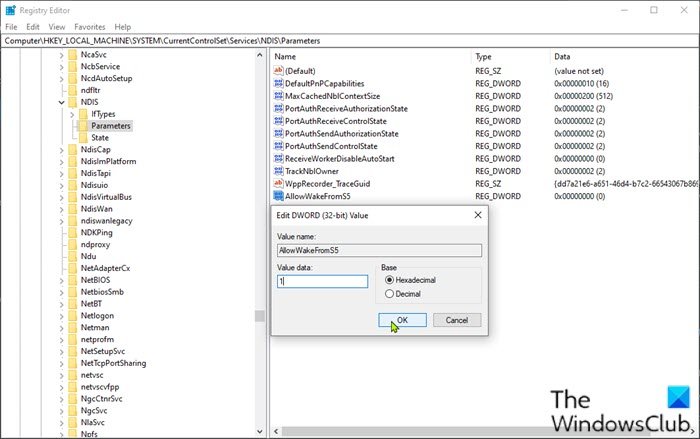
Backup the registry or create a system restore point, then proceed as follows:
- Open Registry Editor.
- Navigate or jump to the registry key path below:
Computer\HKEY_LOCAL_MACHINE\SYSTEM\CurrentControlSet\Services\NDIS\Parameters
- At the location, on the right pane, right-click on a blank space and select New > DWORD (32-bit) Value.
- Name it AllowWakeFromS5.
- Now, double-click the newly created key to edit its properties.
- In the properties windows, set the Value data to 1.
- Click OK to save changes.
- Exit Registry Editor.
- Restart your computer.
The issue should be resolved. Otherwise, try the next solution.
8] Check BIOS settings
If Wake on LAN is not working, the problem might be your BIOS settings. To fix the problem, you need to boot into BIOS and adjust some settings.
Ensure that WOL is enabled in the BIOS under Power Management settings.
Ensure that Deep Sleep is disabled in the BIOS (not applicable to all systems). This power-saving setting turns off the NIC.
If you have Allow PCI to wake up the system setting available in BIOS be sure to enable it as well.
Once done, save changes and check if that solves the problem.
Note: It may be necessary to boot to the Windows desktop after changing the BIOS settings in order for them to be properly applied. There is some interaction between the BIOS settings and the NIC driver settings in Windows.
9] Reset BIOS
This solution requires you to reset BIOS to default settings and then enable APM – you can do that by going to the Advanced section. Wake on LAN feature should start working now. If not, continue with the next solution.
10] Update BIOS
At this point, if you’re still experiencing the issue, you can try updating the BIOS on your system.
Using tools from OEMs is the easiest way to do so. All OEM manufacturers have utilities that help you easily update, BIOS, firmware, and drivers. Search for yours and download it from the official site only. This is the safest way to update the BIOS.
- If you own a Dell laptop you can head over to Dell.com, or you could use Dell Update Utility.
- ASUS users can download the MyASUS BIOS update utility from the ASUS support site.
- ACER users can go here. Enter your Serial Number/SNID or search for your product by Model, select BIOS/Firmware, and click the Download link for the file you want to download.
- Lenovo users can use the Lenovo System Update Tool.
- HP users can use the bundled HP Support Assistant.
Once you complete the manual update of the BIOS on your system, the WOL issue should be resolved.
Any of these solutions should work for you!
Does Windows 11 support Wake-on-LAN?
Windows 11 supports Wake-on-LAN technology. However, if your system does not fulfill the hardware requirements for Wake-on-LAN technology, you will not be able to use it on your Windows 11 computer. If your motherboard and your network card support Wake-on-LAN, you will see an option to enable and disable it in your BIOS.
How to enable WOL in BIOS?
Computers of different brands have different methods to enable Wake on LAN in BIOS. If you want to use Wake on LAN, first, you have to enable it in your system BIOS. After that, you have to enable it in your network adapter settings. Usually, the option to enable or disable Wake-on-LAN in BIOS is available under the Power Options section. In some systems, it is available under the Advanced tab in BIOS. Refer to your computer’s user manual to know how to enable WOL in BIOS.
That’s it.
Leave a Reply